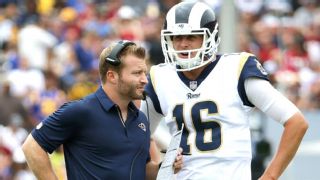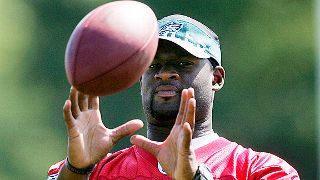|
LOS ANGELES -- The heightened excitement and the lofty expectations that surround these Los Angeles Rams have been tempered, somewhat, by the faint-yet-lingering presence of a recent cautionary tale. The 2011 Philadelphia Eagles, who carried the burden of a “Dream Team” moniker all the way through a disastrous season, have occasionally been linked to a 2018 Rams team that is suddenly bursting with star talent.
 In a stretch of six days, from July 28 to Aug. 2, those Eagles added seven impact players to a team coming off a division title, prompting new backup quarterback Vince Young to bestow upon them a label that would haunt them all year. The Eagles thought their frantic offseason would propel them to the Super Bowl. Instead, they began 4-8 and ultimately missed the playoffs for the first time in four years. Along the way, they reinforced some valuable lessons -- that free agency is dicey, that team chemistry is fragile and that the proverbial superteam might not work so well in the NFL. In a stretch of six days, from July 28 to Aug. 2, those Eagles added seven impact players to a team coming off a division title, prompting new backup quarterback Vince Young to bestow upon them a label that would haunt them all year. The Eagles thought their frantic offseason would propel them to the Super Bowl. Instead, they began 4-8 and ultimately missed the playoffs for the first time in four years. Along the way, they reinforced some valuable lessons -- that free agency is dicey, that team chemistry is fragile and that the proverbial superteam might not work so well in the NFL.
So, what does that say about this year’s Rams? Well, nothing. Yet. Comparisons between those Eagles and these Rams can’t truly be made until this season plays out. But some glaring similarities exist, as do some notable differences. Let’s explore some, just for fun.
SIMILARITIES
Circumstances: The Eagles won the NFC East, lost in the wild-card round and then, motivated by the prospect of a resurgent quarterback in Michael Vick, decided to go all-in. They added two elite corners -- Nnamdi Asomugha and Dominique Rodgers-Cromartie -- as well as defensive end Jason Babin and defensive tackle Cullen Jenkins. They also sprinkled in running back Ronnie Brown, offensive lineman Evan Mathis and Young. The Rams won the NFC West, lost in the wild-card round, and then, motivated by the prospect of a developing quarterback in Jared Goff, decided to go all-in. They added two elite corners (Aqib Talib and Marcus Peters), a dominant interior lineman (Ndamukong Suh) and a true No. 1 receiver (Brandin Cooks).
Uncertainty at linebacker: The Eagles beefed up their secondary and their pass rush with hopes of improving a unit that allowed a then-franchise-record 31 touchdowns through the air in 2010. But that came at the expense of linebacker, where they integrated a rookie fourth-round pick (Casey Matthews) and had questions about the incumbent starters (Jamar Chaney and Moise Fokou). The Rams freed up the salary-cap space to add Talib and Suh by parting with a couple of core pieces in outside linebacker Robert Quinn and inside linebacker Alec Ogletree, both of whom will be replaced internally. They’re generally hoping to piece it together at linebacker, similar to what the Eagles attempted.
Impact talent: Adding proven, high-impact talent also means injecting strong personalities into a volatile ecosystem. It’s a risky proposition that did not work well for the Eagles (example: Asomugha reportedly ate lunch out of his car on practice days rather than with teammates). ESPN Eagles reporter Tim McManus, who covered the 2011 team for the ESPN Radio affiliate in Philadelphia, doesn’t see many obvious similarities between the 2011 Eagles and the 2018 Rams. “But I think the chemistry part can be applicable,” McManus said. “It’s a risk any time you’re bringing in big-name, high-priced free agents and adding them to a group that showed a level of harmony, at least from afar, as the Rams did last year. You run the risk of disrupting that.”
DIFFERENCES
Coordinator turnover: The Rams lost their offensive coordinator when Matt LaFleur left to join the Tennessee Titans in January. But on the Rams, head coach Sean McVay calls the offensive plays. He’ll replace LaFleur by committee, with offensive line coach Aaron Kromer serving as the running game coordinator and Shane Waldron stepping in as the passing game coordinator. But not much, if anything, will change about the offense. A lot did change, however, when the Eagles swapped defensive coordinators in 2011. Sean McDermott was fired from that post and replaced, inexplicably, by Juan Castillo, a longtime offensive line coach. Castillo wasn’t ready to guide the defense. He made the young Matthews his middle linebacker and signal-caller, a role he was not ready to take on. He also turned Asomugha into a rover, forcing him to learn the plays for multiple positions in a new scheme. Both moves cost the Eagles. The Rams have a legendary defensive coordinator in Wade Phillips, who should only help.
Changes along the offensive line: On the laundry list of what went wrong for the 2011 Eagles, the offensive line ranked near the bottom. Mathis was perhaps the least heralded of the new additions, but he was among the most productive. From 2010 to 2011, the Eagles improved in sack percentage (8.0 to 5.5) and generated almost as many rushing yards per carry (5.4 to 5.1). But integrating a new offensive line became one of several adjustments heading into the season, specifically along the interior. The Eagles had a new left guard in Mathis, plus a rookie center (Jason Kelce) and a rookie right guard (Danny Watkins). The Rams return all five starters from last year’s formidable offensive line (left tackle Andrew Whitworth, left guard Rodger Saffold, center John Sullivan, right guard Jamon Brown, right tackle Rob Havenstein). It’s one of many reasons they’re so optimistic.
 The lockout: This part cannot be overstated. A dispute between the players and the owners caused a 130-plus-day lockout from March to July 2011. Players and coaches were not allowed to interact during that time. Organized team activities never took place, training camp was shortened, and so the Eagles scrambled to integrate several new players at important positions. It hurt them. The Rams won’t have that problem. In fact, McVay will only be more comfortable in his second year as an NFL head coach. The same can be said for Goff as a third-year quarterback who is now fully integrated into the offense, and an entire defense that is now more closely in line with Phillips’ 3-4 principles. The lockout: This part cannot be overstated. A dispute between the players and the owners caused a 130-plus-day lockout from March to July 2011. Players and coaches were not allowed to interact during that time. Organized team activities never took place, training camp was shortened, and so the Eagles scrambled to integrate several new players at important positions. It hurt them. The Rams won’t have that problem. In fact, McVay will only be more comfortable in his second year as an NFL head coach. The same can be said for Goff as a third-year quarterback who is now fully integrated into the offense, and an entire defense that is now more closely in line with Phillips’ 3-4 principles.
If there’s one thing the Rams can learn from those Eagles, it’s this: Stay quiet. The Eagles’ season might have turned on July 30 during what would’ve otherwise been a routine training camp news conference. In a makeshift tent near the practice field that day, Young wore a red jersey and a green visor and was asked about all the moves the Eagles made in a short offseason. “Dream team,” he said, then he chuckled. The line, harmless as it might have been, made headlines throughout the country and put an unnecessary target on the Eagles’ backs, ratcheting up the pressure for a season that already had enough of it. The Rams have made no such proclamations, toeing the line between confidence and humility. McVay hopes it stays that way. “There’s a confidence that this group has that you feel good about,” he said, “but I think there’s also got to be humility and an understanding that you have to earn it every single day. ... It’s a very competitive league. There are 31 other great teams in this league that are striving to do the same things that we are. We know that we are confident in the personnel that we have here, but we also know that they’ve got to wipe the slate clean every year. Some of the success we had last year won’t win us any games this year, and I think our players respect and understand that.”
|
